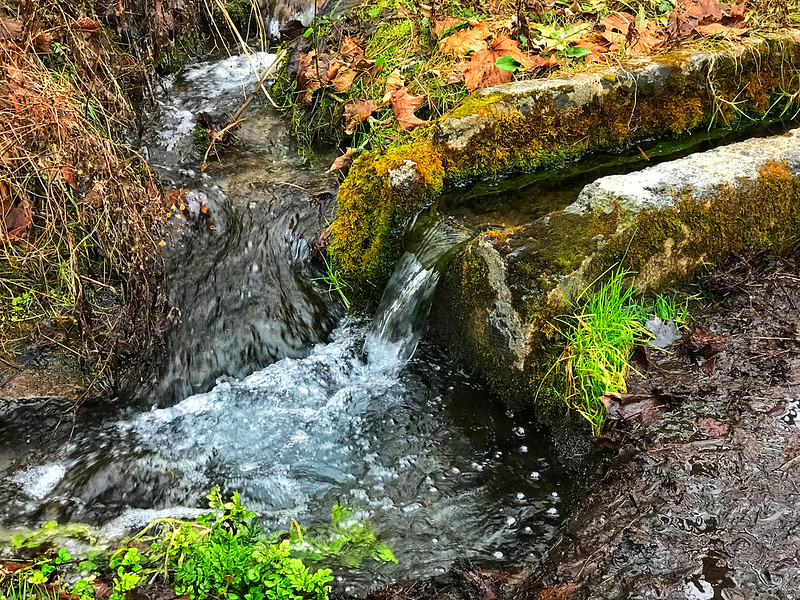Pennsylvania spring water
As a child, I didn’t think about water until I started visiting a friend whose family drank well water that smelled and tasted of sulfur. The odor permeated their house. “You get used to it,” she said. Accustomed to the tasteless taste of “city water,” invariably I felt thirsty the moment I arrived. I never got used to it.
Forty-five years ago the typical person didn’t carry a water bottle or buy bottled water. We drank whatever came out of the tap. Unswayed by Dr. Strangelove or decades of bottled water marketing, I still do, and that’s what I fill my insulated water bottles with when traveling.
On our annual pilgrimage to Pennsylvania in the 1960s and early 1970s, we used to stop at a couple of roadside springs and fill a jug or two with spring water. We didn’t need to. Our “city water” in New York was fine with us — well, as fine as any water in our polluted world can be. There didn’t seem to be any objection to our hosts’ water, either. By the time I was sentient, we were no longer staying with anyone who lacked indoor plumbing. My guess is my parents liked the idea of getting water from a roadside spring and preferred it as a rare treat. I did too. Water straight from a spring — as nature intended. (We didn’t boil it, either.)
Later we stopped at the usual places and found signs indicating the water was too contaminated to drink — the effects of coal mining. My heart broke a bit at the loss of a tradition and the sense the earth itself was dying one roadside spring at a time. After all, I was being raised in the era of the fiery Cuyahoga River, algae-choked Lake Erie, and the horrors of Love Canal.
I wish I could remember where those springs were and find out if anything has changed.
According to findaspring.com, which seems to be defunct, Pennsylvania leads the U.S. in the number of listed springs with 84. New York is second with 59, while Illinois lags behind with only 17 shown.
When I was visiting my cousin for Christmas 2018, I found out they’ve taken to collecting and drinking spring water. My cousin hinted, however, that the spring is far from picturesque. In my mind’s eye, I saw an ugly, chipped-up plastic pipe protruding from an ugly, denuded hillside in town. Something like that.
The spring is south of Tyrone, so we used a visit to Village Pantry as an excuse to get some water. It’s on a lightly traveled road paralleled by a stream, Elk Run, that seems to cross back and forth under it in several places.
My cousin and his wife quickly set up an efficient two-person jug-passing and -filling operation while I meandered back and forth across the road, drinking in (so to speak) the sights and sounds of the spring and Elk Run on its journey.

When a house buyer sees a stream, he pictures flooding, damage, and dollars. I picture myself at a church picnic at Chestnut Ridge, a lifetime ago, walking on 18-Mile Creek, listening to its gushing and trickling, soaking in the sight of countless tiny drops, waterfalls, and eddies, and hoping to spot tadpoles, frogs, minnows, and fish in the clear water reflecting a perfect summer sun filtered on the edges by healthy trees. I had no way of knowing how ephemeral that experience would be.
Memories.
I don’t know how clean or safe the water from this spring is. As I said, it’s south of Tyrone, whose paper mills wafted their distinctive odor through my aunt’s screen door seven or eight miles away in Bellwood. I’ve seen a discussion about agricultural runoff in the area as well, although many think it’s insignificant.
Elk Run appears to be a tributary of the Little Juniata River. I once told my dad I’d seen a leopard frog in the Little Juniata as it runs past Logan Valley Cemetery in Bellwood. He made a wry comment about it, perhaps “How many legs did it have?” Now he and my mother are buried in Logan Valley. Cemetery, within earshot of the Little Juniata. Water, however clean it is or is not, connects us — all of us. We shouldn’t forget that.
Curious about the current state of the Little Juniata, given I’d been handed two bottles of spring water, I found out it’s not as bad as I thought.
Well, the Little Juniata River is not well-known nationally, primarily because it’s only been a trout stream since around 1975. The reason being that prior to that it was literally an open sewer.
Bill Anderson, president of the Little Juniata River Association
After decades of pollution and a “mysterious pollution event in 1997,” we have brown trout fishers to thank for cleaning up the Little Juniata and shoring up its eroding banks.
We want to make sure this resource stays open for our children and grandchildren.
Bill Anderson
This would have made Dad happy. And he didn’t fish.

I’ve been drinking this water my whole life. My father purchased the water rights to this spring in 1950, there’s a pipe inside that runs to my house where we’ve used it for potable/drinking water since 1950 to the present. Any questions feel free to reach me at Reeses.coolspring@gmail.com
Your spring is beautiful. Springs seem to be uncommon in Illinois, at least northeastern Illinois, and they’re not pretty like this (and no hillsides). I think you and my cousin may have spoken at one time several years ago.